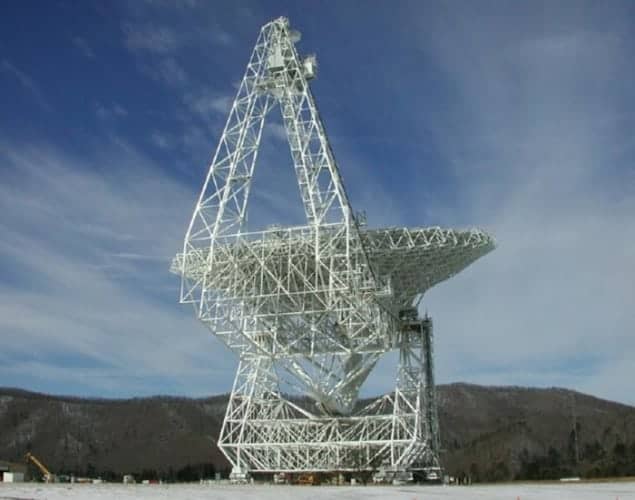
Physicists have drawn up ambitious plans to detect very low-frequency gravitational waves – ripples in the fabric of space–time that general relativity predicts ought to pervade the universe. But rather than looking for them using existing facilities like the LIGO detectors in the US, which are designed to detect tiny changes in the interference patterns of laser beams sent down pairs of kilometre-long pipes positioned at right angles to one another, the idea is instead to use radio telescopes on Earth. The telescopes would measure tiny variations in the output of pulsars spread thousands of light-years apart.
The galactic observatory, proposed by the North American Nanohertz Observatory for Gravitational Waves (NANOGrav), would rely on minute changes in the relative timing of emissions from different pulsars – rapidly rotating neutron stars that emit very regular pulses of radio waves. A gravitational wave passing between a pulsar and a radio telescope affects the time it takes for the emissions to arrive, and so an array of pulsars with different lines of sight to the Earth would reveal the presence of any wave as well as its direction of propagation and polarization.
This idea was first put forward in the late 1970s but requires such high-precision measurements that it has not been technically feasible until now. The NANOGrav team says that it should be possible to correlate the output of 40 pulsars, each with a timing precision better than 100 ns, within the next decade. This would allow astronomers to observe gravitational waves with wavelengths of several light-years coming from sources such as the black-hole binaries that form when galaxies merge, as well as early-universe phenomena such as cosmic strings or inflation.
The NANOGrav consortium says that this could be achieved by expanding the time currently devoted to pulsar observations on existing facilities such as the Arecibo Observatory in Puerto Rico and Green Bank Telescope in West Virginia, US, as well as developing advanced software to process the huge amounts of data involved. It estimates this would cost a few tens of millions of dollars over the next 10 years, in addition to the money spent by their European and Australian collaborators.
This is small fry compared with the hundreds of millions of dollars being spent on gravitational-wave interferometers. Indeed, NANOGrav member Fredrick Jenet of the University of Texas at Brownsville says it is possible that the pulsar network could detect gravitational waves before the interferometers, although he points out that having different approaches not only expands the astrophysics that can be studied, but also improves the chances of detecting gravitational waves in the first place.
Jim Hough, a gravitational-wave researcher at the University of Glasgow and a member of the GEO-600 gravitational-wave observatory based in Germany, says that pulsar timing “looks a very good way” to search for gravitational waves at extremely low frequencies. He believes that by observing 20 pulsars with a timing precision of better than 100 ns for five years, Jenet and colleagues “have a very good possibility of observing gravitational-wave signals”.



